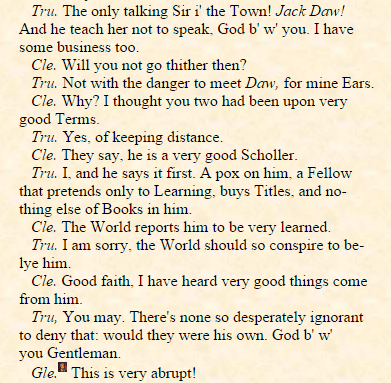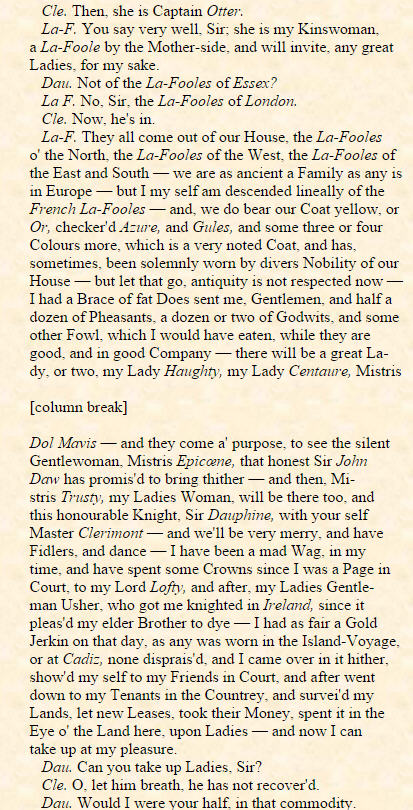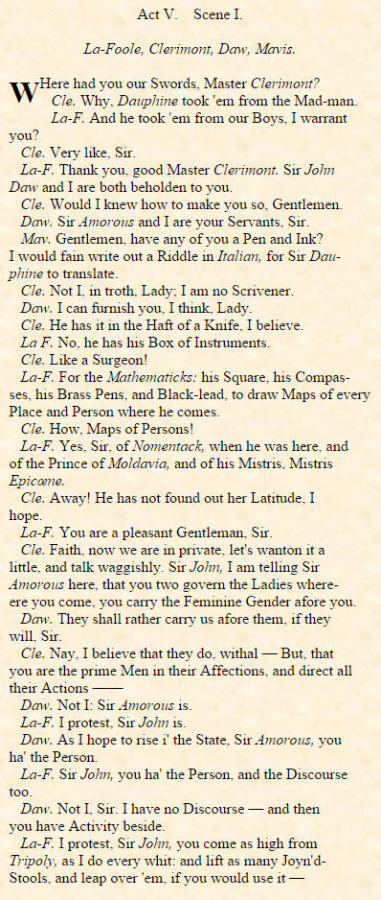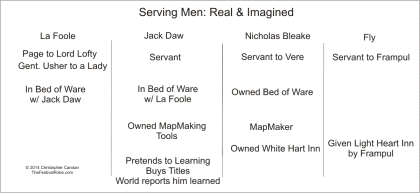Posts from — November 2014
La Foole Me Six Times
Gentleman Usher number six is Amorous La Foole of Ben Jonson’s Epicene, or The Silent Woman.
The play is online here.
The bulk of Rambler’s commentary on Epicene is from 2013; May 12, May 13, May 14, and May 15.
Jack Daw is, in part, Shaksper. Here’s what we know of him from the above scene.
1. Pretends to learning.
2. Buys titles.
3. Nothing else of Books in him.
4. World reports him “very learned.”
5. World ‘conspires’ to belye him.
6. People hear ‘good things come from him’ – BUT ‘would that they were his own.’
La Foole was a page to ‘Lord Lofty’ before he was gentleman usher to a Lady. Richard Dutton, editor of the Revels edition of the play comments on this passage in his introduction. “…a career at court as (we suspect) the sexual plaything first of a lord, then of a lady.” We have seen this sexuality implied with the page as “tumbling boy” kept by Vere in 1583 and reported by Burghley. I suspect that boy was the young Shaksper. We’ve seen repeated insinuations of flirtations between Shaksper figures and older women standing for Queen Elizabeth in other plays in this blog, Cortezza/Mendice and Poll-Marten/Lady Tub specifically.
Jack Daw had tools “to draw Maps of every Place and Person where he comes.” Earlier I wrote about the Bed of Ware, which Jack Daw and La Foole were in together. The famous Bed was an attraction at an Inn in Ware, an Inn that was owned by a former servant of Vere, Nicholas Bleake. In addition to being a servant of Vere in his youth and the host of the White Hart Inn, he was a mapmaker! There are correspondences between Bleake and Fly from Jonson’t later play, The New Inn as I pointed out in that earlier post on the Bed of Ware. Putting it all together gives us the table below.
The connection between Daw and the Bed of Ware as well as the mapmaking tools is a very specific allusion pointing to him as a servant of Vere.
You can read about Nicholas Bleake and the Bed of Ware here.
I think Daw is a meld of two Vere servants, Shaksper/Bleake, while La Foole is a Vere/Shaksper meld. Once again, and for the sixth time, we have Vere/Shaksper allusions connected to a gentleman usher. Let’s recap.
The Six Gentleman Ushers
- Mendice/Bassiolo – Mendice is Alphonso’s implied usher, counterpoint to Bassiolo an usher and Vere character in Chapman’s The Gentleman Usher.
- Poll-Marten – Lady Tub’s usher in Jonson’ A Tale of a Tub.
- D’Olive’s missing usher in Chapman’s Monsieur D’Olive.
- Argus, usher to the widow Countess in Chapman’s The Widow’s Tears.
- Ambler and then De-vile; Lady Tail-bush’s ushers in Jonson’s The Devil is an Ass.
- Amorous La Foole, usher to a Lady in Jonson’s Epicene.
Link to all Usher Series category posts.
We have arrived at the point where the weight of the evidence says a gentleman usher was involved, somehow, in the Shakespeare Authorship Question. Jonson and Chapman have equally provided repeated clues and information, with many consistent cross-references between them. And yet, we know that ethically-challenged scholars beholden to tourist industry stipends will remain unconvinced, claiming randomness, which at this point is there only fall back to this substantial accumulation of evidence. We’ve arrived at this point by following the bread crumb trails laid out by Rambler in Quake-speare Shorterly, that indispensable and extraordinary survey of so many Vere and Shakspere allusions in the literature of Shakespeare’ contemporaries. Now it occurs to me, if we use a different methodology to apply what we now know about gentleman ushers, we could possibly unearth more evidence. And, since such evidence shouldn’t exist, according to the Stratfordian position, the finding of such evidence would disprove their contentions in and of itself. And, if that evidence were particularly persuasive, then it’s a new ball game.
There’s one more post to come to wrap up this Usher Series.
more anon.
November 17, 2014 No Comments





